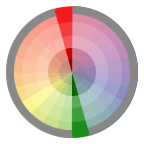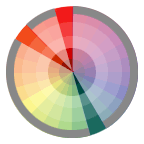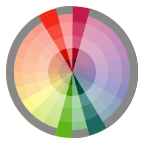Color Worqx
Color Combinations
Color combinations may pass unnoticed when pleasing, yet offend dramatically when compositions seem to clash. One outcome we seek in the final form or composition, is a successful use of color.
We determine whether or not we are successful by critically assessing the visual balance and harmony of the final composition—balance and harmony are achieved by the visual contrast that exists between color combinations. Planning a successful color combination begins with the investigation, and understanding, of color relationships.
Using a color wheel and a template, the relationships between colors are easy to identify.
 Monochromatic Relationship Colors that are shade or tint variations of the same hue.
Monochromatic Relationship Colors that are shade or tint variations of the same hue.
 Complementary Relationship Those colors across from each other on a color wheel.
Complementary Relationship Those colors across from each other on a color wheel.
 Split-Complementary Relationship One hue plus two others equally spaced from its complement.
Split-Complementary Relationship One hue plus two others equally spaced from its complement.
 Double-Complementary Relationship Two complementary color sets; the distance between selected complementary pairs will effect the overall contrast of the final composition.
Double-Complementary Relationship Two complementary color sets; the distance between selected complementary pairs will effect the overall contrast of the final composition.
 Analogous Relationship Those colors located adjacent to each other on a color wheel.
Analogous Relationship Those colors located adjacent to each other on a color wheel.
 Triad Relationship Three hues equally positioned on a color wheel.
Triad Relationship Three hues equally positioned on a color wheel.
Continue tutorial, view: Color & Contrast
